
Home About Us Contact Us Subscribe

Home About Us Contact Us Subscribe
|
|
|
|
Pritzker Prize (Surprise!?!): Glenn Murcutt, Sydney, Australia
A sole practitioner who treasures - and respects - the Australian environment wins what is considered the "Nobel Prize" in architecture. by Kristen Richards April 18, 2002 Editor’s note: Links to “full articles” may expire by week’s
end, or require additional registration. May is a perfect time of
year to be in Rome. An added incentive this year would be to schedule a trip to
coincide with the Pritzker
Prize ceremony on May 29th. Guests from around the world will assemble atop
Michelangelo’s Campidoglio to honor the 25th Pritzker Laureate, Australian
architect Glenn Murcutt. Who??? “There is nothing ordinary
about Mr. Murcutt's work. He has had the kind of focused career many
architecture students dream about, before getting lost in the commercial
thicket and ending up designing strip shopping centers.” – David Dillon, Dallas
Morning News (full
article) He is considered one of
Australia’s best-kept secrets and, at the same time, one of the world’s most
influential architects. According to reports, no one is more surprised about
receiving the Pritzker Prize than Murcutt. "It’s beyond anything I could
have possibly imagined. It’s such an honor and such a privilege to join those
before me," Murcutt told Architectural Record. "It means that at one
level in my country, which is a fairly conservative country, this will raise
the bar." (full article) "Getting
the prize was a terrible shock," the Sydney-based Murcutt said during an
interview with Nicolai Ouroussoff of the Los Angeles Times. "What is
amazing is that it has gone to someone of my stature. I work with no staff, no
secretary, and no computer-aided design. I don't even have a cellular phone. It
is a small operation--just me." (full
article) That, in a nutshell,
explains his relatively low profile, in terms of main-stream press, In fact,
this is the first time since its inauguration in 1979 that the Pritzker has
been awarded to a sole practitioner. Adding to the “who?” factor is that in his
40-something years of practice, 66-year-old Murcutt has not designed anything
outside of Australia, and most of his work has been residential. Pritzker
Prize jury chairman, J. Carter Brown, commented, “Glenn Murcutt occupies a
unique place in today’s architectural firmament. In an age obsessed with
celebrity, the glitz of our ‘starchitects,’ backed by large staffs and copious
public relations support, dominate the headlines. As a total contrast, our
laureate works in a one-person office on the other side of the world from much
of the architectural attention, yet has a waiting list of clients, so intent is
he to give each project his personal best. He is an innovative architectural
technician who is capable of turning his sensitivity to the environment and to
locality into forthright, totally honest, non-showy works of art.” Actually, Murcutt is hardly
a "secret" since he travels
the world teaching and lecturing at universities (including Yale University School of
Architecture; Washington University, St. Louis; University of Pennsylvania; the state universities of Texas, Arizona,
Kansas, and Hawaii). He has also been the subject of numerous books and
international magazine articles. One of the first definitive works was “Glenn Murcutt: Buildings and Projects”
by Françoise Fromonot, first published in 1995 (now out of print – but perhaps
not for long). In that book, she describes Murcutt as the "first
Australian architect whose work has attracted international attention." (books
by and about Glenn Murcutt) An
element of that attention is his approach to architecture (often a stark
contrast to his contemporaries) that includes an unabashed opposition to the people who exercise much control over what
and how things should be built, and perhaps offers a glimmer as to why he has
so few public projects under his belt: "I have had to fight for my
architecture. I have fought for it right from the outset because councils have
clearly found the work a threat. For many designs I put to council, we either had
to resort to a court for the outcome or better, negotiate a satisfactory
result, always trying to avoid a compromise. I have had the greatest trouble
with planning, building, and health department staff, many of whom have
backgrounds unrelated to architecture, but offer very conservative judgments in
taste and aesthetics. "I am not interested in
designing large scale projects. Doing many smaller works provides me with many
more opportunities for experimentation. Our building regulations are supposed
to prevent the worst; they in fact fail to stop the worst, and at best
frustrate the best — they certainly sponsor mediocrity. I’m trying to produce
what I call minimal buildings, but buildings that respond to their
environment.” His primary clients are
residential, who want houses that are not only environmentally sensitive, but
provide privacy and security in structures that please all the senses. The Aboriginal people in
Western Australia have a saying, "to touch this earth lightly," which
is a plea for man not to disturb nature any more than necessary. Murcutt’s
architecture conveys that thought with his houses that float above the land on
stilts a full story high, or footings that disturb the land minimally. In many,
there are places for nature’s creatures (frogs, snakes, etc.) to escape
flooding without disturbing human habitants. In other projects, otherwise
intrusive swimming pools and water features are more than design features –
they are integral fire-fighting elements for protecting the environment (including
creatures) from all-too-frequent wildfires. (It is also interesting to note
that very few of Murcutt’s homes/environments require air-conditioning.) Ouroussoff
of the LA Times said: “Murcutt is best known for designing small, rural houses
that combine a Modernist aesthetic with a deep sensitivity to the environment.
Over a 40-year career, he has built a body of work whose central theme is the
desire to heighten our awareness of the natural landscape – its sounds, smells
and climate. His best designs rest on the landscape with an almost reverential
delicacy.” Thomas
J. Pritzker, president of The Hyatt Foundation which sponsors the prize, said,
“Glenn Murcutt is a stark contrast to most of the highly visible architects of
the day — his works are not large scale, the materials he works with, such as
corrugated iron, are quite ordinary, certainly not luxurious; and he works
alone. The headline by Geraldine
O'Brien, Architecture Writer for the Sydney Morning Herald declared “For just a
lucky few, masterly Murcutt is a household name.” She continued: “Murcutt is
best known to Australians for his use of corrugated iron in elegant and
supremely livable houses which have elevated the humble Aussie shed to an art
form.” (full
article) In what we take as kudos to
Murcutt, Herbert Muschamp of the New York Times offered: “His designs are
formally rigorous, minimal structures that recall the work of Charles and Ray
Eames. But Mr. Murcutt's selection by the Pritzker jury can be seen as an
acknowledgment that sustainability now overrides aesthetic criteria in the
urbanizing world. He added a keen observation (barb?) to the Pritzker jury:
“Pritzker Prize watchers may note that it has been 11 years since an American
architect received this honor, and many may suspect that this is not a simple
case of oversight.” (full article)
In 1992, Murcutt was
presented with the seventh Alvar Aalto Medal. The jury for that award,
specifically praised his work for "the convincing synthesis of regional
characteristics, climate-conditioned solutions, technological rationality and
unconstrained visual expression." Glenn has since commented that he
thought it significant that Jørn Utzon, Alvaro Siza, and Tadao Ando were all
previous winners of the Aalto Medal, and in his words, "all of them sought
to marry modern architecture to the place, the territory, the landscape." It is not surprising that
Murcutt says: "I am stirred to the point of anger when I see what
continues to be done by so called progress – the destruction of the flora, the
displacement of the fauna and all of it with the blessing, if not active
collusion of our subdivision regulations. I am not rejecting urbanization. I am
not seeking a kind of utopia in the bush — far from it. I am involved with and
recognize the importance of a varied milieu. I am opposed to the total taming
of this land and the loss of the wildness of the native scene. The land appeals
for care and we need to become friends with the landscape and not be threatened
by it." Murcutt says, "A
building should be able to open up and say, ‘I am alive and looking after my
people,’ or instead, ‘I’m closed now, and I’m looking after my people as well.’
This to me is the real issue: buildings should respond. …They should open and
close and modify and re-modify …That is a part of architecture for me, the
resolution of levels of light that we desire, the resolution of the wind that
we wish for, the modification of the climate as we want it. All this makes a
building live." One of Murcutt’s favorite
quotations, which he is not quite sure whether it comes from his father (who
taught him a love for nature and architecture) or from Thoreau, whom his father
was so fond of quoting: "Since most of us spend our lives doing ordinary
tasks, the most important thing is to carry them out extraordinarily
well." Comments by Pritzker
Prize Jurors Jury: Chairman: J. Carter Brown Director emeritus, National Gallery of Art;
Chairman, U.S. Commission of Fine Arts Giovanni Agnelli Chairman emeritus, Fiat, Torino, Italy Ada Louise Huxtable Author and Architectural
Critic, New York City Carlos Jimenez Professor, Rice University
School of Architecture; Principal, Carlos Jimenez Studio, Houston, Texas Jorge Silvetti The Lord Rothschild Executive
Director: Bill Lacy |
(click on pictures to enlarge) 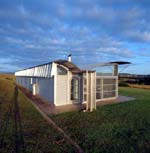 (Anthony Browell) Magney House, Bingie Bingie, South Coast, NSW, 1982-84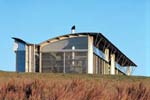 (Anthony Browell) Magney House, Bingie Bingie, South Coast, NSW, 1982-84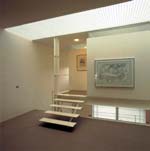 (Anthony Browell) Magney House, Paddington, Sydney, NSW, 1986-90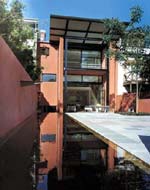 (Max Dupain) Magney House, Paddington, Sydney, NSW, 1986-90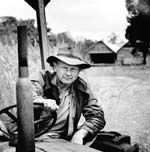 (Anthony Browell) Glenn Murcutt on his tractor pursuing his other activity: farming.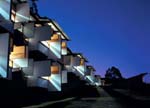 (Anthony Browell) Arthur & Yvonne Boyd Education Centre, Riversdale, NSW, 1996-99 (in collaboration with Wendy Lewin and Reg Lark) (Glenn Murcutt) Arthur & Yvonne Boyd Education Centre, Riversdale, NSW, 1996-99 (in collaboration with Wendy Lewin and Reg Lark) (Anthony Browell) Arthur & Yvonne Boyd Education Centre, Riversdale, NSW, 1996-99 (in collaboration with Wendy Lewin and Reg Lark) (Glenn Murcutt) Bowral House, Southern Highlands, NSW, 1997-2001 (Anthony Browell) C. Fletcher & A. Page House, Kangaroo Valley, NSW, 1997-2000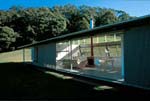 (Glenn Murcutt) C. Fletcher & A. Page House, Kangaroo Valley, NSW, 1997-2000 (Glenn Murcutt) C. Fletcher & A. Page House, Kangaroo Valley, NSW, 1997-2000 (Glenn Murcutt) Simpson-Lee House, Mt. Wilson, NSW, 1989-94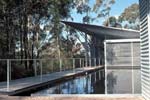 (Glenn Murcutt) Simpson-Lee House, Mt. Wilson, NSW, 1989-94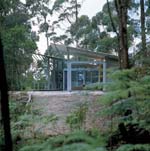 (Anthony Browell) Simpson-Lee House, Mt. Wilson, NSW, 1989 -94 (Glenn Murcutt) Marika-Alderton House -Yirrkala Community, Eastern Arnheim Land, Northern Territory, 1991-94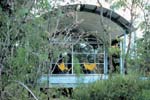 (Glenn Murcutt) Ball-Eastaway House, Glenorie, Sydney, NSW, 1980-83 (Glenn Murcutt) Ball-Eastaway House, Glenorie, Sydney, NSW, 1980-83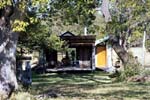 (Glenn Murcutt) Murcutt Guest Studio - Kempsey, NSW, 1992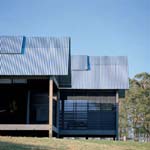 (Glenn Murcutt) Marie Short House, Kempsey, NSW, 1974-75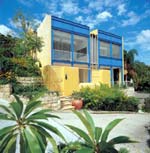 (Reiner Blunck) Done House, Mosman, Sydney, NSW, 1988-91 |
© 2002 ArchNewsNow.com